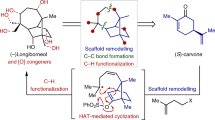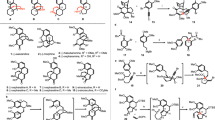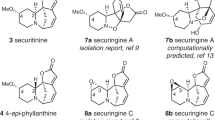Abstract
Stephacidin A and its congeners are a collection of secondary metabolites that possess intriguing structural motifs. They stem from unusual biosynthetic sequences that lead to the incorporation of a prenyl or reverse-prenyl group into a bicyclo[2.2.2]diazaoctane framework, a chromene unit or the vestige thereof. To complement biosynthetic studies, which normally play a significant role in unveiling the biosynthetic pathways of natural products, here we demonstrate that chemical synthesis can provide important insights into biosynthesis. We identify a short total synthesis of congeners in the reverse-prenylated indole alkaloid family related to stephacidin A by taking advantage of a direct indole C6 halogenation of the related ketopremalbrancheamide. This novel strategic approach has now made possible the syntheses of several natural products, including malbrancheamides B and C, notoamides F, I and R, aspergamide B, and waikialoid A, which is a heterodimer of avrainvillamide and aspergamide B. Our approach to the preparation of these prenylated and reverse-prenylated indole alkaloids is bioinspired, and may also inform the as-yet undetermined biosynthesis of several congeners.
This is a preview of subscription content, access via your institution
Access options
Access Nature and 54 other Nature Portfolio journals
Get Nature+, our best-value online-access subscription
$29.99 / 30 days
cancel any time
Subscribe to this journal
Receive 12 print issues and online access
$259.00 per year
only $21.58 per issue
Buy this article
- Purchase on Springer Link
- Instant access to full article PDF
Prices may be subject to local taxes which are calculated during checkout





Similar content being viewed by others
References
Newman, D. J. & Cragg, G. M. Natural products as sources of new drugs from 1981 to 2014. J. Nat. Prod. 79, 629–661 (2016).
Gerwick, W. H. & Moore, B. S. Lessons from the past and charting the future of marine natural products drug discovery and chemical biology. Chem. Biol. 19, 85–98 (2012).
Harvey, A. L., Edrada-Ebel, R. & Quinn, R. J. The re-emergence of natural products for drug discovery in the genomics era. Nat. Rev. Drug Discov. 14, 111–129 (2015).
Montaser, R. & Luesch, H. Marine natural products: a new wave of drugs? Future Med. Chem. 3, 1475–1489 (2011).
Williams, R. M. Natural products synthesis: enabling tools to penetrate nature's secrets of biogenesis and biomechanism. J. Org. Chem. 76, 4221–4259 (2011).
Finefield, J. M., Frisvad, J. C., Sherman, D. H. & Williams, R. M. Fungal origins of the bicyclo[2.2.2]diazaoctane ring system of prenylated indole alkaloids. J. Nat. Prod. 75, 812–833 (2012).
Li, S.-M. Prenylated indole derivatives from fungi: structure diversity, biological activities, biosynthesis and chemoenzymatic synthesis. Nat. Prod. Rep. 27, 57–78 (2010).
Qian-Cutrone, J., Krampitz, K. D., Shu, Y.-Z., Chang, L. P. & Lowe, S. E. Stephacidin antitumor antibiotics. US patent 6,291,461 (2001).
Qian-Cutrone, J. et al. Stephacidin A and B: two structurally novel, selective inhibitors of the testosterone-dependent prostate LNCaP cells. J. Am. Chem. Soc. 124, 14556–14557 (2002).
Lavey, N. P., Coker, J. A., Ruben, E. A. & Duerfeldt, A. S. Sclerotiamide: the first non-peptide-based natural product activator of bacterial caseinolytic protease P. J. Nat. Prod. 79, 1193–1197 (2016).
Wang, X., You, J., King, J. B., Powell, D. R. & Cichewicz, R. H. Waikialoid A suppresses hyphal morphogenesis and inhibits biofilm development in pathogenic Candida albicans. J. Nat. Prod. 75, 707–715 (2012).
Little, P. R. et al. Efficacy of a combined oral formulation of derquantel-abamectin against the adult and larval stages of nematodes in sheep, including anthelmintic-resistant strains. Vet. Parasitol. 181, 180–193 (2011).
Birch, A. J. & Wright, J. J. Studies in relation to biosynthesis—XLII: the structural elucidation and some aspects of the biosynthesis of the brevianamides-A and -E. Tetrahedron 26, 2329–2344 (1970).
Porter, A. E. A. & Sammes, P. G. A Diels–Alder reaction of possible biosynthetic importance. J. Chem. Soc. D 1103a (1970).
Sunderhaus, J. D. et al. Synthesis and bioconversions of notoamide T: a biosynthetic precursor to stephacidin A and notoamide B. Org. Lett. 15, 22–25 (2013).
Mugishima, T. et al. Absolute stereochemistry of citrinadins A and B from marine-derived fungus. J. Org. Chem. 70, 9430–9435 (2005).
Fuchser, J. Beeinflussung der sekundärstoffbildung bei Aspergillus ochraceus durch variation der kulturbedingungen sowie isolierung, strukturaufklärung und biosynthese der neuen Naturstoffe. PhD thesis, Georg-August-Universität Göttingen (1995).
von Nussbaum, F. Stephacidin B—a new stage of complexity within prenylated indole alkaloids from fungi. Angew. Chem. Int. Ed. 42, 3068–3071 (2003).
Herzon, S. B. & Myers, A. G. Enantioselective synthesis of stephacidin B. J. Am. Chem. Soc. 127, 5342–5344 (2005).
Baran, P. S., Guerrero, C. A., Hafensteiner, B. D. & Ambhaikar, N. B. Total synthesis of avrainvillamide (CJ-17665) and stephacidin B. Angew. Chem. Int. Ed. 44, 3892–3895 (2005).
Baran, P. S., Guerrero, C. A., Ambhaikar, N. B. & Hafensteiner, B. D. Short, enantioselective total synthesis of stephacidin A. Angew. Chem. Int. Ed. 44, 606–609 (2005).
Baran, P. S., Hafensteiner, B. D., Ambhaikar, N. B., Guerrero, C. A. & Gallagher, J. D. Enantioselective total synthesis of avrainvillamide and the stephacidins. J. Am. Chem. Soc. 128, 8678–8693 (2006).
Artman, G. D., Grubbs, A. W. & Williams, R. M. Concise, asymmetric, stereocontrolled total synthesis of stephacidins A, B and notoamide B. J. Am. Chem. Soc. 129, 6336–6342 (2007).
Simpkins, N. S., Pavlakos, I., Weller, M. D. & Male, L. The cascade radical cyclisation approach to prenylated alkaloids: synthesis of stephacidin A and notoamide B. Org. Biomol. Chem. 11, 4957–4970 (2013).
Mercado-Martin, E. V. & Sarpong, R. Unified approach to prenylated indole alkaloids: total syntheses of (–)-17-hydroxy-citrinalin B, (+)-stephacidin A, and (+)-notoamide I. Chem. Sci. 6, 5048–5052 (2015).
Jin, S., Wessig, P. & Liebscher, J. Intermolecular and intramolecular Diels−Alder cycloadditions of 3-ylidenepiperazine-2,5-diones and 5-acyloxy-2(1H)-pyrazinones. J. Org. Chem. 66, 3984–3997 (2001).
Watts, K. R. et al. Utilizing DART mass spectrometry to pinpoint halogenated metabolites from a marine invertebrate-derived fungus. J. Org. Chem. 76, 6201–6208 (2011).
Figueroa, M., González, M. D. C. & Mata, R. Malbrancheamide B, a novel compound from the fungus Malbranchea aurantiaca. Nat. Prod. Res. 22, 709–714 (2008).
Frebault, F. C. & Simpkins, N. S. A cationic cyclisation route to prenylated indole alkaloids: synthesis of malbrancheamide B and brevianamide B, and progress towards stephacidin A. Tetrahedron 66, 6585–6596 (2010).
Feng, Y. et al. Total synthesis of verruculogen and fumitremorgin A enabled by ligand-controlled C–H borylation. J. Am. Chem. Soc. 137, 10160–10163 (2015).
Yang, G. et al. Pd(II)-catalyzed meta-C–H olefination, arylation, and acetoxylation of indolines using a U-shaped template. J. Am. Chem. Soc. 136, 10807–10813 (2014).
Yang, Y., Li, R., Zhao, Y., Zhao, D. & Shi, Z. Cu-catalyzed direct C6-arylation of indoles. J. Am. Chem. Soc. 138, 8734–8737 (2016).
Leitch, J. A., McMullin, C. L., Mahon, M. F., Bhonoah, Y. & Frost, C. G. Remote C6-selective ruthenium-catalyzed C–H alkylation of indole derivatives via σ-activation. ACS Catal. 7, 2616–2623 (2017).
Latham, J., Brandenburger, E., Shepherd, S. A., Menon, B. R. K. & Micklefield, J. Development of halogenase enzymes for use in synthesis. Chem. Rev. (in the press).
Hino, T., Endo, M., Tonozuka, M. & Nakagawa, M. Bromination of 2-ethylthio- and 2-ethanesulfonyl-3-substituted indoles with N-bromosuccinimide. Isolation and reactivities of 1-bromoindoles and 3-bromoindolenines. Heterocycles 2, 565–570 (1974).
Ikeda, M. & Tamura, Y. 3-Haloindolenines—versatile intermediates in the indole chemistry. Heterocycles 14, 867–888 (1980).
Kubota, K., Iwamoto, H. & Ito, H. Formal nucleophilic borylation and borylative cyclization of organic halides. Org. Biomol. Chem. 15, 285–300 (2017).
Mfuh, A. M., Doyle, J. D., Chhetri, B., Arman, H. D. & Larionov, O. V. Scalable, metal- and additive-free, photoinduced borylation of haloarenes and quaternary arylammonium salts. J. Am. Chem. Soc. 138, 2985–2988 (2016).
Chen, K., Zhang, S., He, P. & Li, P. Efficient metal-free photochemical borylation of aryl halides under batch and continuous-flow conditions. Chem. Sci. 7, 3676–3680 (2016).
Cambié, D ., Bottecchia, C., Straathof, N. J. W., Hessel, V. & Noël, T. Applications of continuous-flow photochemistry in organic synthesis, material science, and water treatment. Chem. Rev. 116, 10276–10341 (2016).
Cox, R. J. & Williams, R. M. Synthetic studies towards paraherquamide F: synthesis of the 1,7-dihydropyrano[2,3-g]indole ring system. Tetrahedron Lett. 43, 2149–2152 (2002).
Lodewyk, M. W., Siebert, M. R. & Tantillo, D. J. Computational prediction of 1H and 13C chemical shifts: a useful tool for natural product, mechanistic, and synthetic organic chemistry. Chem. Rev. 112, 1839–1862 (2012).
Fenical, W., Jensen, P. R. & Cheng, X. C. Avrainvillamide, a cytotoxic marine natural product, and derivatives thereof. US patent 6,066,635 (2000).
Sugie, Y. et al. A new antibiotic CJ-17665 from Aspergillus ochraceus. J. Antibiot. 54, 911–916 (2001).
Tsukamoto, S. et al. Notoamides F−K, prenylated indole alkaloids isolated from a marine-derived Aspergillus sp. J. Nat. Prod. 71, 2064–2067 (2008).
Kito, K., Ookura, R., Kusumi, T., Namikoshi, M. & Ooi, T. X-ray structures of two stephacidins, heptacyclic alkaloids from the marine-derived fungus Aspergillus ostianus. Heterocycles 78, 2101–2106 (2009).
Tsukamoto, S., Umaoka, H., Yoshikawa, K., Ikeda, T. & Hirota, H. Notoamide O, a structurally unprecedented prenylated indole alkaloid, and notoamides P−R from a marine-derived fungus, Aspergillus sp. J. Nat. Prod. 73, 1438–1440 (2010).
Zhang, B., Zheng, W., Wang, X., Sun, D. & Li, C. Total synthesis of notoamide F, I, and sclerotiamide. Angew. Chem. Int. Ed. 55, 10435–10438 (2016).
Newmister, S. A. et al. Oxad: a versatile indolic nitrone synthase from the marine-derived fungus Penicillium oxalicum F30. J. Am. Chem. Soc. 138, 11176–11184 (2016).
Liu, L. et al. Versicoamides F–H, prenylated indole alkaloids from Aspergillus tennesseensis. Org. Lett. 19, 942–945 (2017).
Acknowledgements
This work is supported by a grant from the US National Institutes of Health (NIH) (NIGMS RO1 086374). We are grateful for a Japan Society for the Promotion of Science Postdoctoral Fellowship to K.M., a Science without Borders Postdoctoral Fellowship to D.P.S. (Brazil; CSF/CNPq 200205/2014-5), the US National Science Foundation (NSF) Graduate Research Fellowship Program, the American Chemical Society Division of Organic Chemistry and the Hellman Graduate Awards Program (University of California (UC) Berkeley) for awards to E.V.M.-M. and the Natural Sciences and Engineering Research Council of Canada for a Postdoctoral Fellowship to K.G.M.K. We are grateful to D. H. Sherman (University of Michigan) and R. M. Williams (Colorado State University), as well as D. Tantillo (UC Davis), for helpful discussions regarding the prenylated and reverse-prenylated indole alkaloids, and the NMR CMAD computational analysis, respectively. We thank R. Cichewicz (University of Oklahoma) for an authentic sample of waikialoid A as well as for an initial secondary metabolite screen on the producing P. aspergillus sp. A. Zeeck (Georg-August-Universität Göttingen) is graciously acknowledged for his tireless efforts to locate and obtain analytical data for the material reported by his laboratory in 1995 to be aspergamide B. X-ray crystallography instrumentation is supported by NIH Shared Instrumentation Grant S10-RR027172. The AV-600, AV-500, DRX-500, AVQ-400 and AVB-400 NMR spectrometers are partially supported by NIH Grants SRR023679A and 1S10RR016634-01 and NSF Grants CHE-9633007 and CHE-0130862. The 900 MHz NMR instrument is funded by NIH Grant GM68933. The Molecular Graphics and Computation Facility is funded by the NIH (S10OD023532). We thank K. Owens (UC Berkeley), K. Durkin (UC Berkeley) and Y. Olatunji-Ojo (UC Berkeley) for assistance with DFT computations and A. G. DiPasquale for X-ray crystallographic analysis.
Author information
Authors and Affiliations
Contributions
R.S., K.M. and D.P.S. designed the research with assistance from Y.H. and E.V.M.-M. All synthetic chemistry was performed by K.M., D.P.S., Y.H., E.V.M.-M., D.E.S., S.C.R. and N.K. Computational studies were conducted by D.E.S., K.G.M.K. and K.M. R.S. wrote the manuscript with contributions from all the authors; all the authors were actively engaged in the editing of the manuscript and gave their approval of the final version. K.M. and D.P.S. contributed equally to this work.
Corresponding author
Ethics declarations
Competing interests
The authors declare no competing financial interests.
Supplementary information
Supplementary information
Supplementary information (PDF 20192 kb)
Supplementary information
Crystallographic data for compound X (CIF 2292 kb)
Rights and permissions
About this article
Cite this article
Mukai, K., de Sant'Ana, D., Hirooka, Y. et al. Bioinspired chemical synthesis of monomeric and dimeric stephacidin A congeners. Nature Chem 10, 38–44 (2018). https://doi.org/10.1038/nchem.2862
Received:
Accepted:
Published:
Issue Date:
DOI: https://doi.org/10.1038/nchem.2862
This article is cited by
-
Site selective C–H functionalization of Mitragyna alkaloids reveals a molecular switch for tuning opioid receptor signaling efficacy
Nature Communications (2021)
-
Multidirectional desymmetrization of pluripotent building block en route to diastereoselective synthesis of complex nature-inspired scaffolds
Nature Communications (2018)



